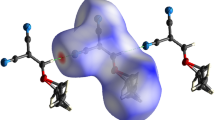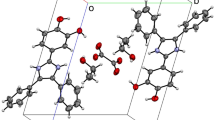Abstract
The title complex has been prepared, and characterized by X-ray crystallography. The crystals are rhombohedral, space groupR32, witha=20.954(5),c=9.753(1) Å,Z=3, andR F =0.070 for 680 observed MoKα reflections. The structure consists of a packing of hexa(3,5-dicarboxypyridine) potassium cations and tetrabromoaurate(III) anions. The potassium atom is surrounded by equivalent oxygen atoms to form a KO6 octahedron with a very short K-O distance of 2.56(1) Å. The AuBr −4 group exhibits orientational disorder with a mean bond length of 2.38(1) Å. Two symmetric strong hydrogen bonds (linear O⋯H⋯O and bent N⋯H⋯N) are found in the crystal structure. The nearly planar organic ligands are interlinked by hydrogen bonds to form parallel sheets which approximately correspond to the (003) family of planes. The potassium atoms lying in between these sheets connect them into a three-dimensional network.
Similar content being viewed by others
References
Bush, M. A., and Truter, M. R. (1971)J. Chem. Soc. (A) 745–750.
Chan, L. Y. Y., and Einstein, F. W. B. (1971)Can. J. Chem 49, 468–476.
Diamond, R. (1969)Acta Crystallogr. A 25, 43–55.
Emsley, J. (1980)Chem. Soc. Rev. 9, 91–124.
International Tables for X-ray Crystallography (1974) Vol. IV (Kynoch Press, Birmingham), pp. 55, 99, 149 (Now distributed by Kluwer Academic Publishers, Dordrecht).
Kopfmann, G., and Huber, R. (1968)Acta Crystallogr. A 24, 348–351.
Manojlović, L., and Speakman, J. C. (1968a)Acta Crystallogr. B 24, 323–325; (1968b)Acta Crystallogr. B 24 326–330.
North, A. C. T., Phillips, D. C., and Mathews, F. S. (1968)Acta Crystallogr. A 24, 351–359.
Ohtaki, H., and Maeda, M. (1976) throughChem. Abstr. 86, 181120.
Poonia, N. S. (1977)J. Sci. Ind. Res. 36, 268–273.
Poonia, N. S., and Bajaj, A. V. (1979)Chem. Rev. 79 389–445.
Sheldrick, G. M. (1982) InComputational Crystallography, Sayre, D. (ed.) (Oxford University Press, New York), pp. 506–514.
Sheldrick, G. M. (1985) InCrystallographic Computing 3: Data Collection, Structure Determination, Proteins and Databases, G. M. Sheldrick, C. Krüger, and R. Goddard (eds.) (Oxford University Press, New York), pp. 175–189.
Sparks, R. A. (1976) InCrystallographic Computing Techniques, F. R. Ahmed (ed.) (Munksgaard, Copenhagen), pp. 442–467.
Speakman, J. C. (1972)Struct. Bonding (Berlin) 12, 141–199.
Author information
Authors and Affiliations
Additional information
On leave from Central Laboratory, Nankai University, Tianjin, China.
Rights and permissions
About this article
Cite this article
Goher, M.A.S., Wang, RJ. & Mak, T.C.W. Crystal structure of hexa(3,5-dicarboxypyridine)potassium tetrabromoaurate(III). Journal of Crystallographic and Spectroscopic Research 20, 245–249 (1990). https://doi.org/10.1007/BF01187249
Received:
Issue Date:
DOI: https://doi.org/10.1007/BF01187249




